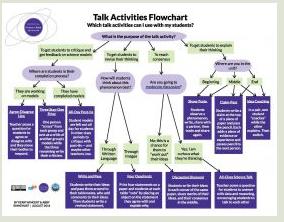Let’s talk science
We know that student discourse and communication play a huge role in our science standards. When you consider the science and engineering practices – many of them require that students engage in discourse. “Asking questions and defining problems,” “constructing explanations,” “engaging in argument from evidence,” and “obtaining, evaluating, and communicating information” all have very strong ties to discussion and student talk.
But many of us struggle with “student discussion.” We either rely on “teacher asks/student answers” as our format or try to have students discuss in groups only to find they themselves struggle with continuing the conversation about the science topic or concepts without a teacher guiding them with questions. What teachers often need is a protocol to encourage students to be involved, engaged, and on-task with their discussions.
 STEM teaching tool #35 offers teachers a wealth of information and guidance on how to foster and cultivate science discourse in their classrooms. While you will be able to find resources on teacher-student talk to enrich your class discussions, you will also find resources on encouraging student-student talk.
STEM teaching tool #35 offers teachers a wealth of information and guidance on how to foster and cultivate science discourse in their classrooms. While you will be able to find resources on teacher-student talk to enrich your class discussions, you will also find resources on encouraging student-student talk.
Within the brief, you will find a link to the Student-Talk Flow Chart. This flow chart is filled with information on various protocols that you can use in your classroom to encourage student-student talk. The flowchart allows the teacher to consider the purpose of the talk activity and then allows the teacher to further drill down to select an appropriate activity, which is then linked to the protocol to be followed.
Take some time and visit the STEM teaching tool #35 and look through the Student-Talk Flow Chart – consider how you might use one of the protocols in an upcoming lesson to encourage more student science discourse in your classroom.
 Reach out to the author – Mandie Sanderman is a science consultant for Central Rivers AEA and can be reached at asanderman@centralriversaea.org .
Reach out to the author – Mandie Sanderman is a science consultant for Central Rivers AEA and can be reached at asanderman@centralriversaea.org .
